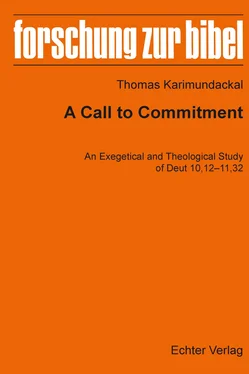67For the connections between the closing verses of ch. 12 and ch. 13, cf. HARMAN, Deuteronomy, 154; WOODS, Deuteronomy, 192.
68The basic source for translation and text-critical notes on the text is MCCARTHY, BHQ Deuteronomy .
69Gall’s critical edition is used for comparing the texts in this study, cf. GALL, Samaritaner, 387-390. Observations on the differences between the Smr and the MT are cited in, KENNICOTT, Vetus Testamentum, 1776-1780; TSEDAKA, Samaritan, 432-435.
70Wevers, in his critical eclectic edition for the Göttingen Septuagint Project, has collated all the available manuscript evidence and grouped it into families, cf. WEVERS, Deuteronomium, 14-15.
71For an overview of the important Qumran manuscripts of Deuteronomy, cf. DAHMEN, Qumran, 271-273.
72DUNCAN, Cave 4 IX, 109-112.
73Ibid., 109.
74MILIK, Grotte 4 II , 48-51.
75Most of the phylacteries of 4Q are dated between the 1 stcentury BCE and the 1 stcentury CE. However, the dates of the phylacteries vary according to their type. For example, the phylacteries classified as “Essenes” belong to the period between the middle of the 2 ndcentury BCE and the first Jewish-Roman war (66-73), and the phylacteries classified as “Pharisees” belong to the period beginning in the 1 stcentury CE, cf. ibid., 46-47.
76Ibid., 67-69.
77Ibid., 75-76.
78Ibid., 80-81.
79MILIK, Grotte 4 II , 81.
80Ibid., 82-83.
81Ibid., 82.
82BAILLET, Les ‘Petites Grottes’, 149-157.
83Ibid., 149.
84Ibid., 158-161.
85The calligraphy of the manuscript is Herodian, cf. ibid., 158.
86BARTHELEMY- MILIK, Cave 1, 72-76.
87CRAWFORD, Cave 4 IX, 15-34.
88DAHMEN, Qumran, 271.
89MILIK, Grotte 4 II , 77-78 .
90SKEHAN, Cave 4 IV , 195-97.
91Ibid., 195.
92DUNCAN, Cave 4 IX, 75-88.
93Ibid., 77.
94Ibid., 93-98.
95DAHMEN, Qumran, 272.
96MILIK, Grotte 4 II , 53-55.
97Ibid., 53.
98Ibid., 55-56.
99Ibid., 62-63.
100Ibid., 78.
101SKEHAN, Cave 4 IV, 131-152.
102DAHMEN, Qumran, 272.
103BARTHELEMY - MILIK, Cave 1, 54-57.
104DAHMEN, Qumran, 271.
105BARTHELEMY - MILIK, Cave 1, 57-62.
106DAHMEN, Qumran, 271.
107However, some of the editors of the manuscripts do make cautious remarks: for example, CRAWFORD, Cave 4 IX, 17, states that 4QDeut ccannot be a manuscript of the Samaritan tradition. The editors of 4QPaleoDeut rstate that it appears to have agreed with the MT and LXX and in minor variants the manuscript most often presents a unique reading, cf. SKEHAN, Cave 4 IV , 134.
108The verb שׁאל may represent the semantic meanings of ‘ask’ and ‘request’, bringing the basic meanings together, namely ‘demand’, cf. WESTERMANN, Begriffe, 9, or ‘appeal to someone, seek something’, cf. Gerleman, 1282 ,שׁאל. However, I prefer to translate ‘demand’ here, as the context suggests a contractual relationship and obligation, cf. FUHS, 261 ,שׁאל. The LXX also uses αἰτεῖται, an indicative present middle verb with a claim to a receipt of an answer or a demand to render the participial predicate שׁאל.
109A substantive in the construct state before the plural of the same word (which is naturally to be regarded as a partitive genitive) is used as a periphrasis for the superlative. ושׁמי השׁמים is such a usage in this context, cf. GKC 431; cf. 1Kgs 8,27; Ps 68,34; 148,4; Neh 9,6; 2 Chr 2,5.
110The particle רק here has an affirmative, assertive force, cf. MURAOKA, Grammar 131, and therefore the phrase is to be understood with a contrasting sense here as “[Yet] only….”. The LXX uses an adverbial conjunction πλὴν to denote a contrast.
111חשׁק literally means ‘attached’ or “lusted after you” or “hung on you” (cf. Gen 34,8; Deut 21,11; Ps 91,14) and for the physical sense “to stick, bind to,” (cf. Exod 27,17; 38,17.28). LXX has differentiated it by προείλατο …. ἀγαπᾶν “to choose to love” and then by ἐξελέξατο to render יבחר, cf. WEVERS, Notes, 182.
112LXX lacks a corresponding term for ערלת but it is translated by περιτεμεῖσθε τὴν σκληροκαρδίαν ὑμῶν. giving a moral interpretation to the foreskin, i.e., the hardness of your heart, cf. WEVERS, Notes, 182.
113את in אתך is taken as a preposition of advantage (cf. 1,30).
114The prepositional use of ב is here identified as beth essentiae, cf. GKC, 119 i.
115Along with the Smr, BHS suggests reading ושׁמרת משׁמרתו וחקתיו as ושׁמרת משׁמרת חקתיו. This suggestion seems to have no strong textual support as the Kennicott manuscripts are of little textual significance and the reference to Josh 22,3 is not a close parallel text. Regarding the sequence of וחקתיו ומשׁפטיו ומצותיו, LXX, Smr, 4QPhyl pand 8QMez follow the sequence of וחקתיו ומצותיו ומשׁפטיו, cf. 8,11; 26,17; 30,16; MCCARTHY, BHQ, 81-82; OTTO, Deuteronomium , 1014. The identical initial and final consonant pairs of ומצותיו ומשׁפטיו might have facilitated the transposition. The Masora of BHS makes a note on the mnemonic sequence giving the correct order: ומצותיו) צ ,(ומשׁפטיו) פ ,(וחקתיו) ק).
116The basic issue of the syntax of v2-7 lies in understanding two problems:
1. How do we understand the particle את before בניכם with no verb governing it?
The particle את before בניכם cannot be taken as an accusative particle as there is no verb governing it. Another possibility is to take את as the preposition “with” and interpret the phrase as elliptical for, “for it is not with your children that I speak …”, cf. GKC §117 l . Therefore, considering את as a direct object marker or preposition would imply a missing verb. However, given the rhetorical context of Moses’ speech the particle את before בניכם can be best understood as an emphatic particle, cf. HALOT, 470; BDB, 85; TIGAY, Deuteronomy, 110; ARAÚJO, Theologie, 209; SCHULMEISTER, Befreiung, 72.
2. How do we understand מוסר in 2d?
a) מוסר can be taken as the direct object of ידעתם in v2a, as it is suggested by the masoretic punctuation and the translation would be: “And you shall know today - for not your children who have not known or seen - the discipline of….”, cf. WEINFELD, Deuteronomy, 442.
b) Since the verbs ידע and ראה in v2cd lack an expressed object, they may anticipate מוסר as their object and therefore the translation would be: “And you shall know today - for not your children who have not known or seen the discipline of the Lord your God - his greatness…” OTTO, Deuteronomium, 1014; WEVERS, Notes, 187 and NELSON, Deuteronomy, 129, go along with this suggestion by reading v2b-2d in parenthesis taking 2e (… את־גדל) as the object of ידעתם in v2a.
However, considering the rhetorical nature of these verses, I suggest taking מוסר as the object of ידע and ראה and v2e-6 as a prolonged continuation of the phrase את־מוסר יהוה אלהיכם in v2d.
117Instead of MT’s ואת־אתתיו ואת־מעשׂיו LXX has καὶ τὰ σημεῖα αὐτοῦ καὶ τὰ τέρατα αὐτοῦ. LXX seems to harmonize with the common pair as in 4,34; 6,22; 7,19; 26,8; 29,2 and 34,11.
118LXX’s treatment of this verse differs from MT for two reasons. First of all, the singular מעשׂה יהוה הגדל (cf. Judg 2,7) is translated plural, as πάντα τὰ ἔργα κυρίου τὰ μεγάλα. Though πάντα τὰ ἔργα κυρίου τὰ μεγάλα could be taken as a translation ad sensum of כל־מעשׂה יהוה הגדל, LXX generally translates כל modifying a singular noun literally (cf. 8,3). LXX’s translation is supported by Vg, Syr, T N, 4QDeut j, 4QDeut k1and 4QPhyl k. MCCARTHY, BHQ, 81, suggests that “the form מעשׂה may have been understood as a plural form since the phonetic identity of מעשׁי/מעשׁה is fairly common in biblical Hebrew”, see also QIMRON, Hebrew § 100.34. Otto’s explanation that מעשׂה יהוה forms an inclusion between 11,3 and 11,7 seems more convincing, and that therefore could be a harmonization in 11,7, cf. OTTO, Deuteronomium 1014-15. The plural הגדולים in 4QDeut k1also corresponds to LXX (τὰ μεγάλα), which is also supported by Vg, Syr, T N. Secondly, in LXX we see an addition of ὑμῖν σήμερον which seems to correspond to 11,4d, where Egypt is described as ויאבדם יהוה עד היום הזה.
Читать дальше












